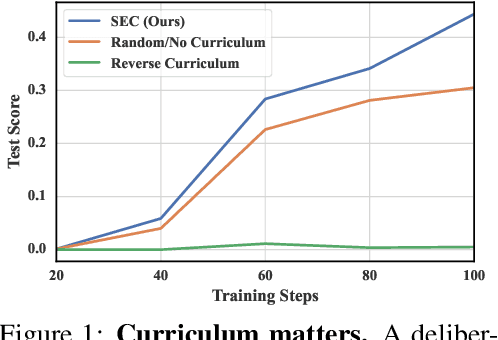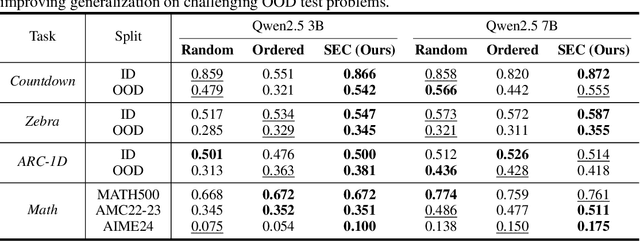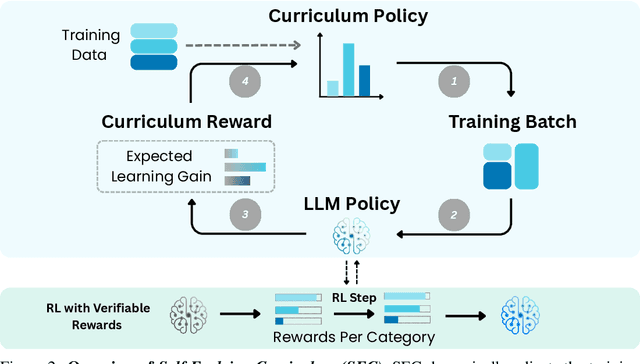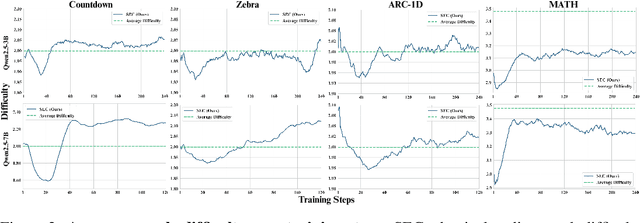Minsu Kim
Efficient Domain Generalization in Wireless Networks with Scarce Multi-Modal Data
Oct 05, 2025Abstract:In 6G wireless networks, multi-modal ML models can be leveraged to enable situation-aware network decisions in dynamic environments. However, trained ML models often fail to generalize under domain shifts when training and test data distributions are different because they often focus on modality-specific spurious features. In practical wireless systems, domain shifts occur frequently due to dynamic channel statistics, moving obstacles, or hardware configuration. Thus, there is a need for learning frameworks that can achieve robust generalization under scarce multi-modal data in wireless networks. In this paper, a novel and data-efficient two-phase learning framework is proposed to improve generalization performance in unseen and unfamiliar wireless environments with minimal amount of multi-modal data. In the first stage, a physics-based loss function is employed to enable each BS to learn the physics underlying its wireless environment captured by multi-modal data. The data-efficiency of the physics-based loss function is analytically investigated. In the second stage, collaborative domain adaptation is proposed to leverage the wireless environment knowledge of multiple BSs to guide under-performing BSs under domain shift. Specifically, domain-similarity-aware model aggregation is proposed to utilize the knowledge of BSs that experienced similar domains. To validate the proposed framework, a new dataset generation framework is developed by integrating CARLA and MATLAB-based mmWave channel modeling to predict mmWave RSS. Simulation results show that the proposed physics-based training requires only 13% of data samples to achieve the same performance as a state-of-the-art baseline that does not use physics-based training. Moreover, the proposed collaborative domain adaptation needs only 25% of data samples and 20% of FLOPs to achieve the convergence compared to baselines.
Diffusion Alignment as Variational Expectation-Maximization
Oct 01, 2025Abstract:Diffusion alignment aims to optimize diffusion models for the downstream objective. While existing methods based on reinforcement learning or direct backpropagation achieve considerable success in maximizing rewards, they often suffer from reward over-optimization and mode collapse. We introduce Diffusion Alignment as Variational Expectation-Maximization (DAV), a framework that formulates diffusion alignment as an iterative process alternating between two complementary phases: the E-step and the M-step. In the E-step, we employ test-time search to generate diverse and reward-aligned samples. In the M-step, we refine the diffusion model using samples discovered by the E-step. We demonstrate that DAV can optimize reward while preserving diversity for both continuous and discrete tasks: text-to-image synthesis and DNA sequence design.
Active Attacks: Red-teaming LLMs via Adaptive Environments
Sep 26, 2025Abstract:We address the challenge of generating diverse attack prompts for large language models (LLMs) that elicit harmful behaviors (e.g., insults, sexual content) and are used for safety fine-tuning. Rather than relying on manual prompt engineering, attacker LLMs can be trained with reinforcement learning (RL) to automatically generate such prompts using only a toxicity classifier as a reward. However, capturing a wide range of harmful behaviors is a significant challenge that requires explicit diversity objectives. Existing diversity-seeking RL methods often collapse to limited modes: once high-reward prompts are found, exploration of new regions is discouraged. Inspired by the active learning paradigm that encourages adaptive exploration, we introduce \textit{Active Attacks}, a novel RL-based red-teaming algorithm that adapts its attacks as the victim evolves. By periodically safety fine-tuning the victim LLM with collected attack prompts, rewards in exploited regions diminish, which forces the attacker to seek unexplored vulnerabilities. This process naturally induces an easy-to-hard exploration curriculum, where the attacker progresses beyond easy modes toward increasingly difficult ones. As a result, Active Attacks uncovers a wide range of local attack modes step by step, and their combination achieves wide coverage of the multi-mode distribution. Active Attacks, a simple plug-and-play module that seamlessly integrates into existing RL objectives, unexpectedly outperformed prior RL-based methods -- including GFlowNets, PPO, and REINFORCE -- by improving cross-attack success rates against GFlowNets, the previous state-of-the-art, from 0.07% to 31.28% (a relative gain greater than $400\ \times$) with only a 6% increase in computation. Our code is publicly available \href{https://github.com/dbsxodud-11/active_attacks}{here}.
Non-Adaptive Adversarial Face Generation
Jul 16, 2025Abstract:Adversarial attacks on face recognition systems (FRSs) pose serious security and privacy threats, especially when these systems are used for identity verification. In this paper, we propose a novel method for generating adversarial faces-synthetic facial images that are visually distinct yet recognized as a target identity by the FRS. Unlike iterative optimization-based approaches (e.g., gradient descent or other iterative solvers), our method leverages the structural characteristics of the FRS feature space. We figure out that individuals sharing the same attribute (e.g., gender or race) form an attributed subsphere. By utilizing such subspheres, our method achieves both non-adaptiveness and a remarkably small number of queries. This eliminates the need for relying on transferability and open-source surrogate models, which have been a typical strategy when repeated adaptive queries to commercial FRSs are impossible. Despite requiring only a single non-adaptive query consisting of 100 face images, our method achieves a high success rate of over 93% against AWS's CompareFaces API at its default threshold. Furthermore, unlike many existing attacks that perturb a given image, our method can deliberately produce adversarial faces that impersonate the target identity while exhibiting high-level attributes chosen by the adversary.
On scalable and efficient training of diffusion samplers
May 26, 2025Abstract:We address the challenge of training diffusion models to sample from unnormalized energy distributions in the absence of data, the so-called diffusion samplers. Although these approaches have shown promise, they struggle to scale in more demanding scenarios where energy evaluations are expensive and the sampling space is high-dimensional. To address this limitation, we propose a scalable and sample-efficient framework that properly harmonizes the powerful classical sampling method and the diffusion sampler. Specifically, we utilize Monte Carlo Markov chain (MCMC) samplers with a novelty-based auxiliary energy as a Searcher to collect off-policy samples, using an auxiliary energy function to compensate for exploring modes the diffusion sampler rarely visits. These off-policy samples are then combined with on-policy data to train the diffusion sampler, thereby expanding its coverage of the energy landscape. Furthermore, we identify primacy bias, i.e., the preference of samplers for early experience during training, as the main cause of mode collapse during training, and introduce a periodic re-initialization trick to resolve this issue. Our method significantly improves sample efficiency on standard benchmarks for diffusion samplers and also excels at higher-dimensional problems and real-world molecular conformer generation.
Energy-based generator matching: A neural sampler for general state space
May 26, 2025



Abstract:We propose Energy-based generator matching (EGM), a modality-agnostic approach to train generative models from energy functions in the absence of data. Extending the recently proposed generator matching, EGM enables training of arbitrary continuous-time Markov processes, e.g., diffusion, flow, and jump, and can generate data from continuous, discrete, and a mixture of two modalities. To this end, we propose estimating the generator matching loss using self-normalized importance sampling with an additional bootstrapping trick to reduce variance in the importance weight. We validate EGM on both discrete and multimodal tasks up to 100 and 20 dimensions, respectively.
Revival with Voice: Multi-modal Controllable Text-to-Speech Synthesis
May 25, 2025Abstract:This paper explores multi-modal controllable Text-to-Speech Synthesis (TTS) where the voice can be generated from face image, and the characteristics of output speech (e.g., pace, noise level, distance, tone, place) can be controllable with natural text description. Specifically, we aim to mitigate the following three challenges in face-driven TTS systems. 1) To overcome the limited audio quality of audio-visual speech corpora, we propose a training method that additionally utilizes high-quality audio-only speech corpora. 2) To generate voices not only from real human faces but also from artistic portraits, we propose augmenting the input face image with stylization. 3) To consider one-to-many possibilities in face-to-voice mapping and ensure consistent voice generation at the same time, we propose to first employ sampling-based decoding and then use prompting with generated speech samples. Experimental results validate the proposed model's effectiveness in face-driven voice synthesis.
Scaling and Enhancing LLM-based AVSR: A Sparse Mixture of Projectors Approach
May 21, 2025Abstract:Audio-Visual Speech Recognition (AVSR) enhances robustness in noisy environments by integrating visual cues. While recent advances integrate Large Language Models (LLMs) into AVSR, their high computational cost hinders deployment in resource-constrained settings. To address this, we propose Llama-SMoP, an efficient Multimodal LLM that employs a Sparse Mixture of Projectors (SMoP) module to scale model capacity without increasing inference costs. By incorporating sparsely-gated mixture-of-experts (MoE) projectors, Llama-SMoP enables the use of smaller LLMs while maintaining strong performance. We explore three SMoP configurations and show that Llama-SMoP DEDR (Disjoint-Experts, Disjoint-Routers), which uses modality-specific routers and experts, achieves superior performance on ASR, VSR, and AVSR tasks. Ablation studies confirm its effectiveness in expert activation, scalability, and noise robustness.
Self-Evolving Curriculum for LLM Reasoning
May 20, 2025



Abstract:Reinforcement learning (RL) has proven effective for fine-tuning large language models (LLMs), significantly enhancing their reasoning abilities in domains such as mathematics and code generation. A crucial factor influencing RL fine-tuning success is the training curriculum: the order in which training problems are presented. While random curricula serve as common baselines, they remain suboptimal; manually designed curricula often rely heavily on heuristics, and online filtering methods can be computationally prohibitive. To address these limitations, we propose Self-Evolving Curriculum (SEC), an automatic curriculum learning method that learns a curriculum policy concurrently with the RL fine-tuning process. Our approach formulates curriculum selection as a non-stationary Multi-Armed Bandit problem, treating each problem category (e.g., difficulty level or problem type) as an individual arm. We leverage the absolute advantage from policy gradient methods as a proxy measure for immediate learning gain. At each training step, the curriculum policy selects categories to maximize this reward signal and is updated using the TD(0) method. Across three distinct reasoning domains: planning, inductive reasoning, and mathematics, our experiments demonstrate that SEC significantly improves models' reasoning capabilities, enabling better generalization to harder, out-of-distribution test problems. Additionally, our approach achieves better skill balance when fine-tuning simultaneously on multiple reasoning domains. These findings highlight SEC as a promising strategy for RL fine-tuning of LLMs.
Adaptive Cyclic Diffusion for Inference Scaling
May 20, 2025Abstract:Diffusion models have demonstrated strong generative capabilities across domains ranging from image synthesis to complex reasoning tasks. However, most inference-time scaling methods rely on fixed denoising schedules, limiting their ability to allocate computation based on instance difficulty or task-specific demands adaptively. We introduce the challenge of adaptive inference-time scaling-dynamically adjusting computational effort during inference-and propose Adaptive Bi-directional Cyclic Diffusion (ABCD), a flexible, search-based inference framework. ABCD refines outputs through bi-directional diffusion cycles while adaptively controlling exploration depth and termination. It comprises three components: Cyclic Diffusion Search, Automatic Exploration-Exploitation Balancing, and Adaptive Thinking Time. Experiments show that ABCD improves performance across diverse tasks while maintaining computational efficiency.
 Add to Chrome
Add to Chrome Add to Firefox
Add to Firefox Add to Edge
Add to Edge